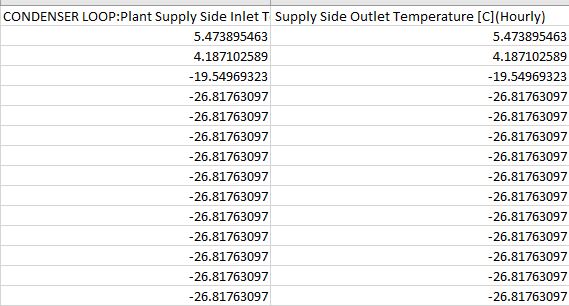VRF water cooled plant temperatures far too cold
Hi Everyone,
This is part two of my original question posted here: https://unmethours.com/question/13686....
@rraustad was kind enough to post a very helpful reply. After I read his reply I investigated my results and discovered that the unmet hours were the result of the VRF system disabling itself often throughout the year as both the heating and cooling mode limits were exceeded.
I tried to fix this issue by setting the minimum outdoor temperature in heating and cooling mode setpoints to the maximum and minmum (100 C and -100 C respectively) so that the VRF would never be disabled.
However when I did this the simulation simply crashed as the plant temperatures "were getting far too cold".
Using the base case model with a 100,000 W cooling tower and the VRF system Water Condensor Volume Flow rate of 10 gallons a minute.
I tested a range of options to try to solve this issue (and in each option I made sure to output the output variables suggested here . These options consisted of:
- Increasing the nominal cooling tower capacity (from 100,000 W to 5275 Kw) with the VRF system Water Condensor Volume Flow rate of 10 gallons a minute .
- Increasing the nominal cooling tower capacity (from 100,000 W to 5275 Kw) with the VRF system Water Condensor Volume Flow rate set to autosize.
With these two models the result was the same unmet hours issue due to the VRF disabling itself. The only difference was that the the VRF disabled itself a few hours later with the autosize flow rate than with the 10 gallons a minute flowrate. Furthermore in both cases the VRF disabled itself a few hours later compared to the basecase which seems to disable itself immediately (Janurary 1st at 1 am). Note that I considered the VRF to disable itself when the CONDENSER LOOP:Plant Supply Side Outlet Temperature [C] plateued as seen below.

- Increasing the Condensor Volume Flow rate from 10 gallons a minute to 50 gallons a minute (With a cooling tower capacity of 100,000 W). Again this only delayed the VRF system disabling itself by one hour. Compare to the basecase.
With the help of the designbuilder team I've submitted a support ticket to the Energy Plus team and I'm hoping we can conduct the discussion here for the benefit of everyone.
The E+ files along with the results for each simulation can be seen in the dropbox here. Does anyone have any thoughts on the issue while we wait for the E+ support team? Thank you!




